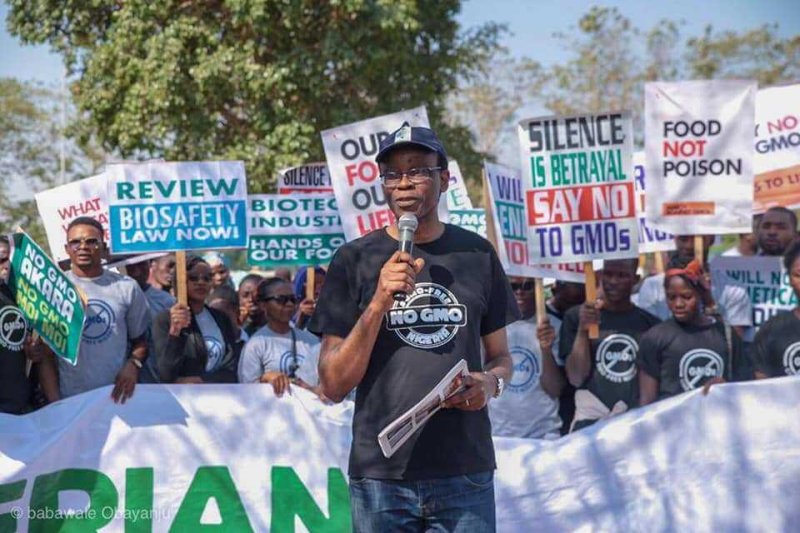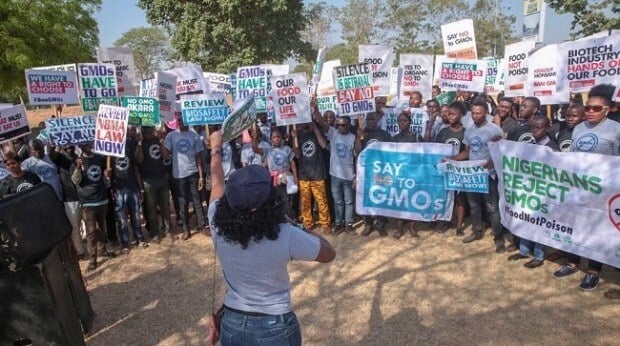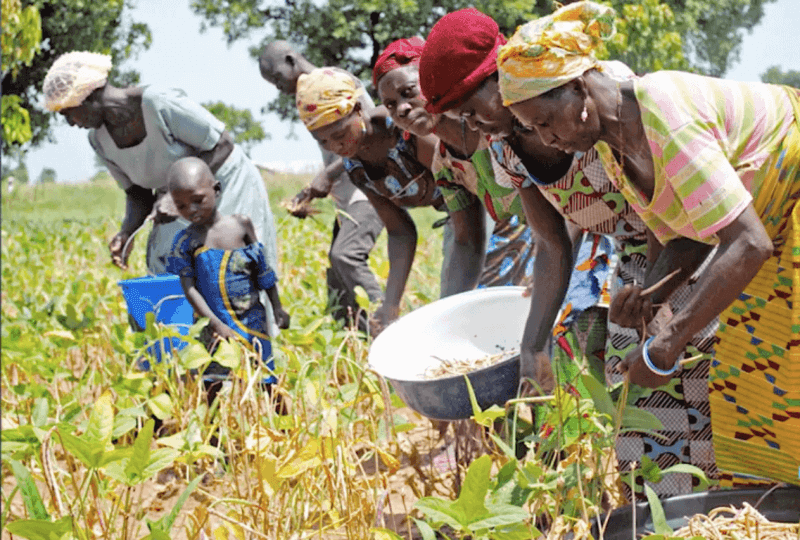The standard for how to conduct a safely assessment is laid down by the Codex Alimentarius, a food code established by the United Nations Food and Agriculture Organization (FAO) and the World Health Organization (WHO) to “protect consumer health and promote fair practices in food trade.” It covers the gamut of food safety from hygienic practices to testing for pesticides, food additives, and veterinary drugs.
For GM foods, the type of testing required is highly technical and detailed. But it’s based on a common-sense approach, points out Don MacKenzie, head of the Institute for International Crop Improvement at the Donald Danforth Plant Science Center in St Louis, Missouri—a not-for-profit center whose mission is to “improve the human condition though plant science.”
MacKenzie illustrated the basic logic of food safety testing with a simple question: “Is there a study that’s looked at the safety of rice?” (There isn’t)
“It’s impossible to prove absolute safety. All you can do is show the GM food is as a safe as the food that we have a long history and familiarity with.”
For a GM plant, testing focuses on the known differences between the traditional variety and the GM version. These differences are the protein products of the introduced genes. They are tested for their toxicity and ability to provoke an allergic response. Researchers can also test whether the insertion of the new genes activates other genes that might trigger toxic or allergic responses.
What could go wrong?
Besides effects on human or animal health, the GM plant undergoes testing for its performance in the field to see if the inserted genes affect the plant’s growth. Finally, there are ecological tests. Could the GM plant lead to the creation of a superweed that infiltrates fields growing traditional varieties or threaten the precious biodiversity of natural varieties of cowpea that grow wild in West Africa?
Again, it’s impossible to prove that such a thing could never happen. The assessment addresses the size of the risk based on existing evidence. For one thing, the domesticated cowpea is an inbreeding species which means it keeps its genes to itself. But a bumblebee is heavy enough that it might succeed in prizing open the closed flowers and cause rare events of cross pollination. If that happened, could the transferred Bt gene turn one of its domesticated or wild relatives into a super weed?
That’s unlikely because the Bt gene does not offer a fitness advantage where it really counts—in the seed. The Bt gene protects the flowers and leaves but unharvested seed is just as vulnerable to beetle or rodent predators. So even if another cowpea variety acquired the Bt gene, its seeds would not be fitter and hence unlikely to turn into a super weed. This is supported by the fact that some wild varieties of cowpea have natural Maruca resistance but have not become super weeds.
As to the concern that wild cowpeas might be swamped by the transfer of genes from the GM variety, there are good reasons that won’t happen. The Bt gene would not transfer in isolation. It would bring along about 50% of the traits of the domesticated plant. The traits that humans prize make the plant less fit—domesticated seeds are white and highly visible to predators, and they tend not to shatter, which is great for harvesting intact pods but bad for the plant’s ability to spread its seed. On top of this, said MacKenzie, after more than two decades of growing other crops containing Bt, there is no evidence of cross-pollination creating superweeds.

Developing the GM cowpea in Higgin’s lab took a decade. Carrying out the necessary safety studies took another. The Donald Danforth Plant Science Center in St Louis, Missouri contributed, carrying out the nutrient composition analysis, helping to co-coordinate field trials and collecting further safety data required for the dossier.
“It takes a certain kind of experience and expertise that doesn’t reside in most universities”, said Don MacKenzie, head of the Institute for International Crop Improvement at the Danforth Center. “Our mission is to do what we can do to shorten the time it takes to put good safe technology in the hands of smallholder farmers. The number of hungry people in the world is going up.”
Indeed, as the latest report from the FAO on the state of food security attests, “the number of people affected by hunger globally has been slowly on the rise since 2014.”
The suitcase sized dossier explained the preparation and properties of the GM pod borer resistant cowpea, commonly referred to as PBR cowpea in forensic detail. The Higgins group showed that the insertion of the foreign genes in the cowpea had no effect on any genes that might have a toxic or allergenic effect. The next level of testing showed the new genes had no effect on the growth or nutritional composition of the plant.
The Bt proteins made by the plant were also shown to be exactly the same as those produced by GM soybeans and maize, and by the bacterial concoctions that organic farmers spray on their crops. There were hundreds of studies attesting to the safety of the Bt protein for human and animal consumption.
Researchers from Higgins’s CSIRO group, the Donald Danforth Plant Science Center, and the University of Nebraska Food and Allergy department concluded “food products derived from 709A cowpea are compositionally equivalent to non-GM plants,” no “unintended or unexpected effect on plant growth general morphology, vegetative vigor, or grain yield,” and “no indications that 709A cowpea would be more invasive … compared to conventional cowpea.”
Insidious campaign against GM cowpeas
While the Nigerian government considered the application, there was a period of public consultation. The anti-GM group “Health of Mother Earth Foundation” rolled into action. Repeating standard tropes, they falsely claimed the GM cowpea would cause cancer and infertility, or that the new GM cowpea would take over and eliminate genetic diversity.
These activists were “branches of opposition from US and European groups planted here,” said Ishikayu. They leveraged social media, newspaper articles and public rallies to roll out scare campaigns. They filed a court case to try and stop the technology.
For Abdourhamane, the opposition is hard to fathom. “Their ideas and arguments are so anti-scientific. They want to take us back to the time of Adam and Eve.” But he notes there are larger politics at play. “European donors who put pressure on African countries not to adopt GMO crops.”
As Harvard’s Paarlberg noted in Resetting the Table: “Organizations like Greenpeace and Friends of the Earth, both based in Amsterdam, were first able to turn European consumers and politicians against GMO foods, then they leveraged Europe’s rejection to launch and win follow-on battles in Asia, Africa and Latin America…. Developing countries don’t want to plant something European importers might refuse to buy.”
In Nigeria, the case for the GM cowpea was helped by a pro-science president and ministers. But it was the grass-roots science movement that won the day, a group led by the Open Forum for Agricultural Biotechnology (OFAB), a team of scientists and regulators under the direction of microbiologist Rose Gidado. At every turn, they met the anti-GM campaigners with a robust counter-offensive.
“We must …make sure that we do not allow frightening untrue stories about a proven technology to hinder our advancement. We must make use of science and technology to make Nigeria greater than she is today,” she told the Nigerian newspaper Vanguard in 2019.
“Kudos goes to Rose Gidado and the forum she leads,” said MacKenzie. “Without their efforts things would have been much different.”
“We explained the case to the public on the strength of the science. If as a scientist I had any doubt as to the benefit, I would say it. My allegiance is to the safety of people before anything,” said Mohammad Ishiyaku,
In December of 2019 science won the day and Nigeria became the first country in the world to approve the commercialisation of genetically modified cowpea.
Over the last year the seeds, which go by the trade name SAMPEA 20-T, have been multiplied by three certified local growers and sold to farmers across the country. “The cost is on par with traditional varieties,” said Ishiyaku. Farmers are free to resow their seeds just as they do with traditional varieties.
“I have personally tried the variety on my farm and can therefore attest to its potential to take the Nigerian farmer out of poverty as well as contribute immensely to the quest for food security in Nigeria,” Arc. Kabiru Ibrahim, President of All Farmers Association of Nigeria, told his members at the June 29th launch.
When I spoke to Ishiyaku at the end of July, he told me almost all the stock of PBR cowpea is gone and farmers are clamoring for more. “They are excited by what they have seen in in planted demonstrations in the north and southwest.
“The big mistake is we didn’t expect this exponential growth in demand for the seed,” said Issoufou Abdourhamane. He and Ishiyaku are making plans to increase the supply of the seed for the next season.
Next steps
Higgins, Singh and Murdock are all into their 70s or beyond. But their dedication to the cowpea is unwavering. While African agriculture remains hamstrung by the lack of roads, power, irrigation, fertilizer and conflict, improved seed is one thing that can make a difference to subsistence farmers, just as it did in Asia, when high-yielding wheat and rice varieties lifted millions out of poverty during the Green Revolution of the 1970s. The cowpea devotees believe that productivity gains from the cowpea will play a role in helping West Africa’s climb.
According to a recent estimate Nigeria’s producers and consumers could gain U.S $350 million over 25 years if a sizable fraction of farmers adapt the PBR cowpea. If adopted at 100% in Nigeria, Niger and Benin, the gain could be at least $840 million per year across the three countries. The new cowpea variety is expected to be taken up by a number of countries in West Africa including Ghana, Burkina Faso, Benin and Niger.
For the cowpea scientists, a wide embrace of their GM cowpea would fulfill the first step in their dream. BB Singh continues his work on improving the crop’s traits, splitting his time between Texas A&M University and G.B Pant University in northern India.
The arms race between plants and pests is never ending. Higgins is continuing to fortify the cowpea in its battle against the destructive Maruca moth. Pests evolve much faster than their hosts. It is just a matter of time before Maruca will develop resistance to the PBR cowpea. But nature has been bounteous when it comes to the insecticidal proteins of Bacillus thuringiensis. There are about 120 different kinds. While Maruca might evolve resistance to one, evolving resistance to two or more is far less likely.
Jose Barrero, Higgins’ heir apparent for the CSIRO cowpea project, is now leading a team developing a “next gen” PBR cowpea that carries two Bt resistance genes: the original cry1Ab and another called cry2Ab.
“We’re working like crazy”, said Higgins, who expects it will be ready in about five years. And then the 77-year-old said, “I can retire.”
Elizabeth Finkel is a former biochemist and editor-at-large of Australian-based Cosmos magazine. Find Elizabeth on Twitter @ElizabethFinkel

































